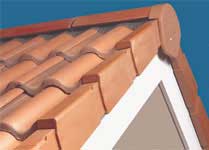On a standard pitched roof on older houses, the area where the tiles meet the gables ends of the house is called the Roof Verge.
The verge acts as a seal and helps to hold the roof tiles in place. Traditional roof verges that use cement or mortar are known as Wet Verges. Over time, water damage, frost damage, or the natural settling of the house can cause the mortar to crack and even fall out. If the damage gets worse it can quickly affect the integrity of the whole roof.
This guide looks at making repairs to roof verges, from fixing small cracks to replacing the verge with a dry verge system. As always when working at height, make sure that you take the proper safety precautions. If you don’t think you can work on the roof safely, it is better to get a professional to do the job.
Repair Small Cracks in Roof Verges
Small cracks in the mortar of the verge can be quickly and easily fixed by using a roof and gutter sealant. This is injected into the crack with the applicator and allowed to dry before being painted over (if required). You can buy sealant in several colours to match the mortar if it is to be left unpainted.
Repair Large cracks or Missing Mortar
Remove any cracked and crumbling mortar with a hammer and chisel, taking it back until it is completely sound. Brush away any dust and small debris with a dry paintbrush. Mix up your mortar using a standard mix of one part Cement to four parts sharp sand (it is also fine to use a pre-mix bag if you wish) and mix in some PVA adhesive as well, following the manufacturer’s instructions. Making the mix slightly dry will make it easier to apply on the vertical surface.
Dampen the area to be filled with water, using an old paintbrush to get into all of the cracks and holes, and then brush it with a coat of PVA adhesive. Start to fill the holes with your mortar, working from the back of the hole or crack and knocking it in with the edge of the trowel to make sure that there are no air pockets. Gradually build up the mortar until it is flush with the surface of the gable end.
To finish off, smooth the surface of the mortar with the trowel and make sure that there are no ledges or horizontal ridges which might retain water and cause future problems. When the mortar is completely dry, paint it if required.
Fitting a Dry Verge
If your mortar roof verge is in very bad condition, it is worth thinking about replacing it with a Dry Verge system.

Dry verges are usually made from moulded UPVC and are available in a variety of colours and styles to match your existing tiles. Lengths of the moulded dry verge are clipped to the edges of the tiles and can really tidy up an unsightly roof.
Dry verges can be fitted to existing roofs, but it is really a job for professionals. Not all dry verges fit all types of roof profile and they are generally specific to a particular type of roof tile.
The dry verge system shown here is available from Eurocell but many other roof verge systems are available.





